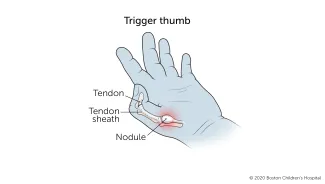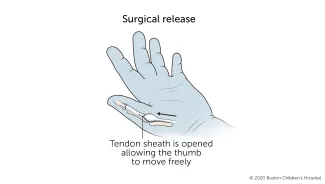Trigger Thumb | Symptoms & Causes
What are the symptoms of trigger thumb?
When a child has trigger thumb, their thumb is stuck in a bent position. You may notice that your child cannot give you a “thumbs up.” You may be able to feel a bump in your child’s palm at the base of the thumb.
Some children with trigger thumb can extend their thumb, though it may be painful and cause swelling. There may also be a noticeable clicking sound.

What causes trigger thumb?
Pediatric trigger thumb occurs by chance and is not related to other disorders.
A band of tissue called a tendon connects the thumb to a muscle in the forearm. Sometimes in children, the tendon grows faster than the protective sheath that surrounds it. The sheath becomes tight, preventing the tendon from gliding easily inside it. The tendon may become swollen and make it difficult (or impossible) for your child to fully extend their thumb.
Trigger Thumb | Diagnosis & Treatments
How is trigger thumb diagnosed?
Your child’s doctor can diagnose this condition by conducting a thorough medical history and physical exam. X-rays are not generally needed to diagnose trigger thumb.
How is trigger thumb treated?
In a small number of children, trigger thumb gets better on its own, without treatment. The chance of this decreases as children get older. Because of this, surgery is recommended for trigger thumbs in children older than 2.
Surgery takes about 30 minutes under general anesthesia. During the surgery, the surgeon makes a small cut in the tendon sheath so that the tendon can move smoothly.
After surgery, your child will probably have to wear a soft bandage for one to two weeks.

What is the long-term outlook for children with trigger thumb?
Most children start using their thumb normally within a few weeks after surgery and have no long-term problems. The chance of the condition returning after surgery is quite small.
How we care for trigger thumb at Boston Children’s Hospital
The Orthopedics and Sports Medicine Department’s Hand and Orthopedic Upper Extremity Program and our Department of Plastic and Oral Surgery’s Hand and Reconstructive Microsurgery Program have treated thousands of babies and children with trigger thumb and other hand problems. We are experienced treating conditions that range from routine to highly complex and can provide your child with expert diagnosis, treatment, and care. We also offer the benefits of some of the most advanced clinical and scientific research in the world.
Our Orthopedics and Sports Medicine Department is nationally known as the preeminent center for the care of children and young adults with a wide range of developmental, congenital, neuromuscular, sports related, traumatic, and post-traumatic problems of the musculoskeletal system.
Our Department of Plastic and Oral Surgery is one of the largest and most experienced pediatric plastic and oral surgery centers anywhere in the world. We provide comprehensive care and treatment for a wide variety of congenital and acquired conditions, including hand deformities.


